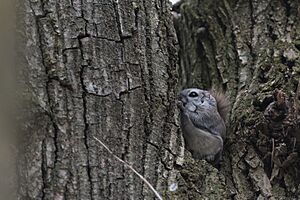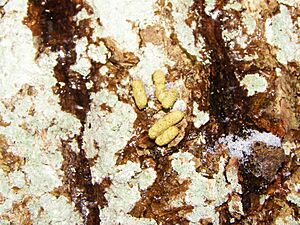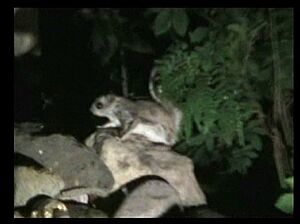Siberian flying squirrel facts for kids
Quick facts for kids Siberian flying squirrel |
|
|---|---|
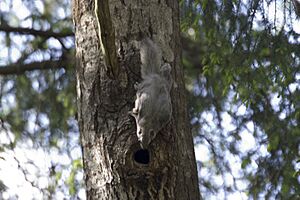 |
|
| next to nesthole | |
| Conservation status | |
| Scientific classification | |
| Genus: |
Pteromys
|
| Species: |
volans
|
| Subspecies | |
|
|
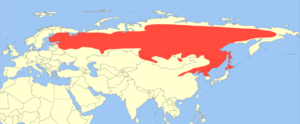 |
|
| Siberian flying squirrel range | |
| Synonyms | |
|
Sciurus volans Linnaeus, 1758 |
|
The Siberian flying squirrel (Pteromys volans) is a small, furry animal that can glide through the air! It lives across a huge area, from the Baltic Sea in the west, all the way across Northern Asia to the Pacific Ocean. It's the only type of flying squirrel found in Europe. Sadly, it's considered vulnerable in the European Union, meaning its numbers are getting low. You can only find them in Estonia and Finland in Europe. In Latvia, they haven't been seen since 2001 and are now thought to be gone from that area.
Contents
About the Siberian Flying Squirrel
A female Siberian flying squirrel usually weighs about 150 grams. Males are a little smaller. Their body is about 13 to 20 cm long. Their tail is flat and measures 9 to 14 cm. They have big, dark eyes.
Their fur is grey all over. Their belly is a bit lighter than their back. They also have a black stripe between their neck and front leg. A special part of flying squirrels is their furry gliding skin. This skin, called a patagium, stretches between their front and back legs. When they spread this skin, they can glide from tree to tree. They can glide over a hundred meters!
Behavior
Diet
Siberian flying squirrels eat many different things. Their diet includes leaves, seeds, cones, buds, and berries. They also enjoy nuts and fresh sprouts. If there are lots of alder and birch catkins, the squirrel might save them for winter. They store these snacks in old woodpecker holes or other cozy spots.
Reproduction and Life Cycle
These squirrels mate in early spring. In southern Finland, the first mating season starts in late March. A second mating season can happen in April. After about five weeks, the mother squirrel gives birth. She usually has two or three babies, called young. Each baby weighs only about 5 grams!
They like to build their nests in holes made by woodpeckers. But they can also use birdhouses if the entrance is the right size. The nest is a soft pile of materials. They especially like soft beard lichen. The squirrel then burrows into this soft pile. Siberian flying squirrels can live for about five years.
Habitat
Siberian flying squirrels prefer old forests. These forests have a mix of conifers (like pine trees) and deciduous trees (trees that lose their leaves). They are mostly active at night. They are busiest late in the evening. However, mothers with young babies might look for food during the day.
They do not hibernate (sleep through the winter). But in cold weather, they might sleep for several days in a row. Since they are shy and active at night, people rarely see them. The easiest way to know they are around is by finding their droppings. These look like orange-yellow rice grains. You can often find them under or on top of their nest.
Predators
Several animals hunt Siberian flying squirrels. Their predators include martens, hawks, owls, dogs, and cats.
In Human Culture
The Siberian flying squirrel is an important symbol in some places. It is the special animal of Nuuksio National Park in Espoo, Finland. This is because many flying squirrels live there. In Estonia, the Siberian flying squirrel is on the logo of the Estonian Nature Fund.
Threats to the Squirrel
In Finland and the Baltic states, the Siberian flying squirrel is at risk. It could become an endangered species. P. volans has already disappeared from Lithuania. It was also thought to be gone from Belarus since 1996. But in 2017, it was spotted again! More than 80 squirrel homes were found in northern Belarus in 2019.
Things that are causing their numbers to drop include habitat loss. This means their forest homes are being cut down or broken into smaller pieces. Climate change also plays a role. They need special forests, like old spruce forests, to live. Because Finland is part of the European Union, the squirrel is protected by an EU rule from 1992. The EU, Finland, and Estonia are working together. They have a six-year project with 8.9 million euros to help protect these special squirrels.



